Every social media marketer has had some low-performing posts.
But do all these posts qualify as social media mistakes?
The answer is NO. There could be multiple reasons behind the non-performance of a post – sometimes it’s the algorithm, sometimes it’s timing, and sometimes it’s just the audience having an off day.
However, there are some avoidable errors that can be prevented when you build your organization’s or client’s presence on social media. These could be due to a wrong strategy or a marketing practice that may backfire. But knowing them is the key to avoiding these mistakes
So, what are these social media fails that brands make (often without realizing it) and how to avoid them before they snowball into missed opportunities?
Let’s find out.
Social media marketing is a great means for brands to grab attention. But sometimes brands make mistakes that bring them into the limelight for all the wrong reasons.
Here are some ways in which common social media mistakes by companies can tarnish their reputation:
1. Affect Your Discoverability
Brands often avoid the SEO guidelines or do not add relevant keywords and hashtags when posting on social platforms. Such mistakes can affect their discoverability and make them lose their visibility in spaces where their prospective customers are looking for them.
2. Wastage of Content Asset
Content can be a great asset when it is rightly used and reused on social media. However, some brands keep reinventing the wheel and do not optimally utilize their best-performing content.
3. Dilute Your Brand Identity
When brands are inconsistent with their voice, style, or tone on social media sites, it tends to confuse their followers. One such example was the infamous social media campaign by GAP, where they literally divided audiences with their unity call during the 2020 US presidential elections.
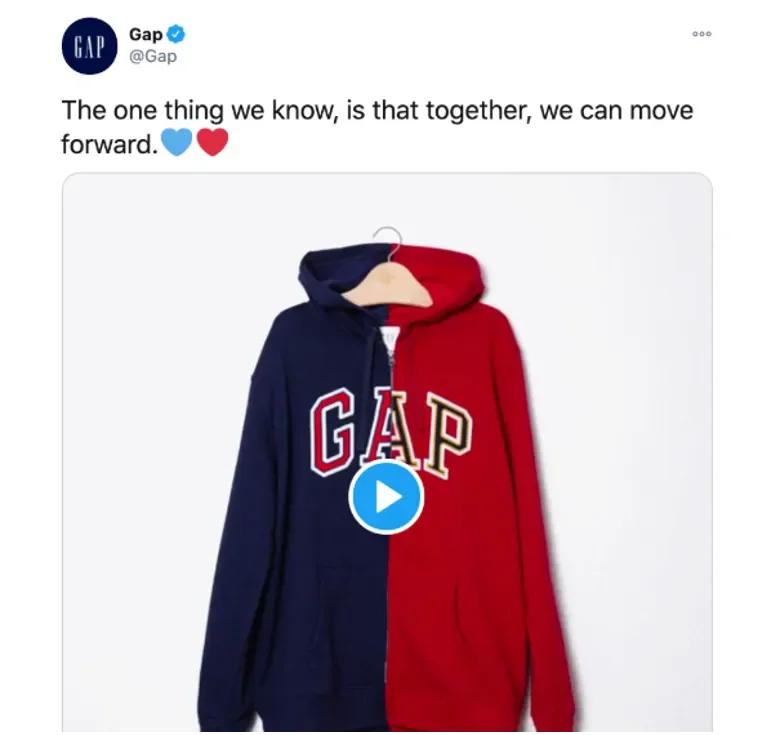
4. Lead to Engagement Decay
Some social media mistakes, like over-reliance on social media tools, posting content that’s too robotic, or ignoring the comments of your followers online, can substantially decline your engagement rates over time.
5. Erode Your Brand Trust
This is the worst one! Because the trust once broken is hard to mend. Poor social media management can also damage your online reputation to the extent that your followers lose their faith in you.
For instance, when Chase blamed their customers for their poor finances, their message quickly backfired, thus leading to a drop in their followers.
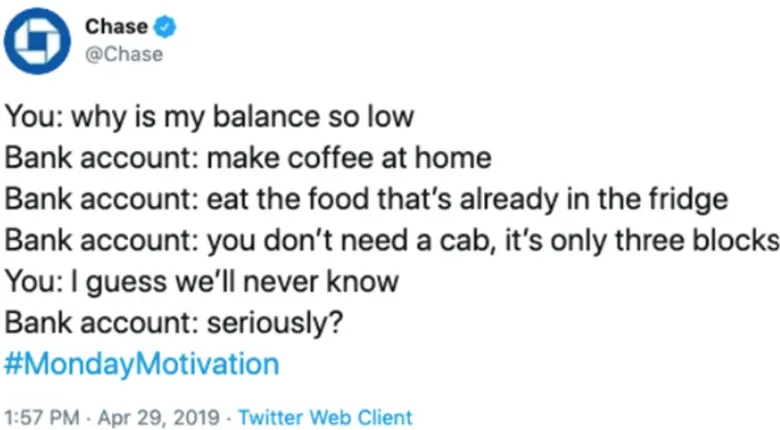
GoodFirms conducted a survey to find out why some brands were being unfollowed on their social media networks, and here are some top reasons that prompt social media users to unfollow a brand online.
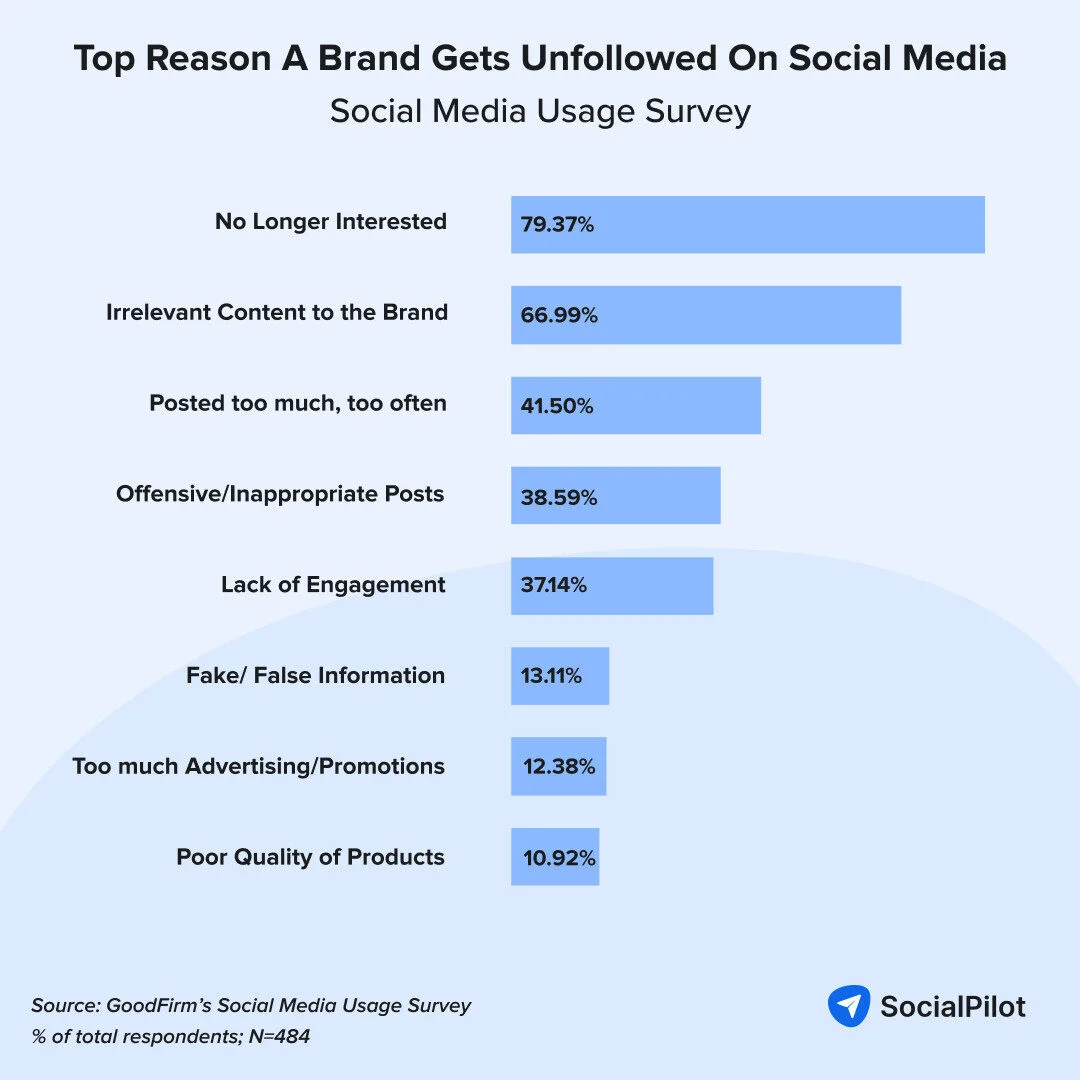
While creating a strategy for social media might look like an obvious thing to do, many businesses fail to do it. They often post random things on social media channels without setting a clear objective. But such posts lead them nowhere.
So, if you are a business making the same mistake, start by setting some specific objectives as to what it is that you want to achieve. Then come up with a periodic plan (like quarterly or monthly) and finally break it down into easy weekly tasks that you can track. Determine the resources you would need, and based on that, decide a monthly budget for social media.
One of the most impactful social media marketing strategies that we came across was Airbnb’s #WeAccept campaign in 2017.
When the brand started, it faced a major challenge — trust. Convincing people to let strangers stay in their homes or book homes online wasn’t easy. So, Airbnb changed its marketing strategy from simply promoting its listings to promoting the feeling of belongingness.
During the Super Bowl, it released a 30-second ad featuring diverse faces with the message, “We all belong.” The hashtag quickly spread, generating over 87 million impressions in the first week. By centering its strategy on emotion, inclusion, and storytelling, Airbnb built a community-driven brand image rather than just a booking platform.
This tells us that having a clear, purpose-led strategy can turn your product or service into a global movement. Create a winning social media marketing strategy for your business before you actually start posting.
2. Not Building the Buyer Persona
5.6 billion social media users.
Not all of them can be your target audience. What is the point of posting content for an audience that doesn’t care? Not only will your content get wasted, but it will also not bring any leads or conversions.
The solution to this is having a clearly defined buyer persona for all your social media marketing campaigns. Understand the goals, pain points, and social media behaviors of your audience.
Basically, having a buyer persona will help you understand who you are talking to, based on which you can create content that directly speaks to them.
But how can brands create a buyer persona? This could be done by analyzing the performance of your previous posts in terms of demographics. Dig into the following details:
- Check age, location, active hours, engagement type, and top-performing content.
- See what demographics and interests dominate your website traffic.
- What are their interests, goals, challenges, motivations, and values?
- Who’s actually buying your product?
- How do they first discover you?
- What type of content do they trust, or what triggers a purchase or signup
Once you ascertain your niche audience, focus on targeting them by posting relevant content.
Nike, for instance, has broken down their audience to the core; they know exactly who they are and what makes them buy.
Their social media strategy revolves around a well-defined persona of an everyday athlete, someone who may never run a marathon but wants to feel empowered. Campaigns like “Find Your Greatness,” “You Can’t Stop Us,” and “Just Do It” celebrate determination and inclusivity, not just performance.
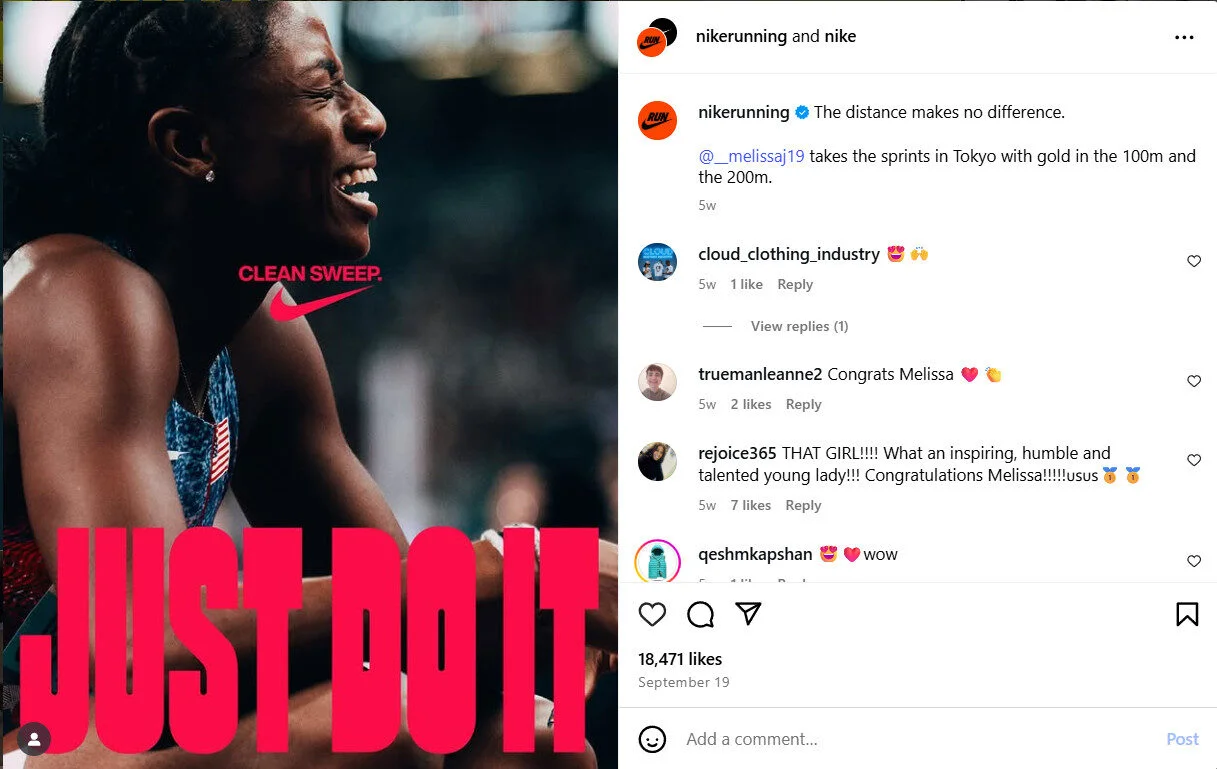
By tailoring its messaging to this persona, Nike consistently creates emotionally charged content that resonates with its global audience.
3. Ignoring Audience Analytics
Unless you don’t test how deep your waters are, you can never determine what step to take next. Social media analytics help you ascertain which posts are working and which are not. At the same time, conducting an in-depth social media audience analysis will help you decipher who your audience is, what they care about, and when they’re most active.
Based on these insights, brands can improvise and improve their social media strategies based on their strong and weak points. Start by finding a good social media analytics tool that helps you track your post performance and provides key marketing insights.
Keep a check on engagement metrics, customer conversions, buying trends, and their overall influence on your social media performance.
Want to know exactly what’s working on your socials? Use SocialPilot’s Social Media Analytics to uncover deep insights and make data-driven decisions.
SocialPilot helps you:
- Track engagement, impressions, and reach for every post.
- Understand your followers’ demographics, interests, and behavior.
- View analytics for all your social profiles in one dashboard.
- Compare growth and engagement across different time periods.
- Export branded PDF reports for clients or social media teams.
- Post when your audience is most active.

4. Posting Too Much or Too Little (Inconsistent posting)
In a survey conducted by HubSpot, 44% of Instagram marketers said that not posting enough on Instagram is the number one reason brands lose followers.
But still, we often find brands posting inconsistently on social media platforms; some days they post a lot, and on other days, they completely disappear. It is important for brands to understand how often to post on social media platforms because building a strong social presence requires balance and consistency.
Every social media platform has an ideal posting frequency. Here are the recommended numbers of posts for some popular platforms:
- Facebook – 1-2 posts a day
- Twitter – 3-7 tweets a day
- Pinterest – 10-15 pins a day
- LinkedIn – 1 post per day
- Instagram – 1-2 posts a day
Follow these posting frequency guidelines and use social media scheduling tools to plan your posts in advance, so you never miss out on the peak engagement hours.
Also, remember to customize your post content depending on the social media platforms where you are posting. For instance, you can post case studies on LinkedIn but not on Instagram.
5. Poor Engagement
Social media is a two-way street, but many brands still treat it like a broadcast channel. They may post regularly, but they do not respond to mentions, comments, or DMs; sometimes, they even delete the negative feedback to make their profile look flawless.
This is indeed a very common social media error that not only kills your engagement but also makes your brand look disconnected and unapproachable. So, there are multiple tactics brands can use to boost social media engagement, because when engagement drops, it signals to algorithms that your content isn’t worth showing.
To begin with, make your followers feel more seen and heard by engaging with them. Here are some best practices to avoid social media disasters:
- Acknowledge the positive feedback; even a simple “like” or “thank you” can do the magic.
- Address all the negative comments within 24-48 hours and don’t keep your unhappy customers waiting for long.
- Ask questions and invite feedback in your posts. This will make your followers feel more involved.
- Post polls, quizzes, or stories once in a while for better engagement.
- Set aside some time every day to check your notifications and engage with your community.
If you do not show up for your social media followers, they may eventually lose interest in your business and unfollow you. So make sure to engage. This will boost your brand reach and help you gain more brand loyalty.
6. Being too Salesy or Over-Promoting Yourself
The ultimate goal of every social media manager is to increase the brand’s sales, but acting only for sales can make your audience drift away.
As a brand, you must first win the trust of your audience and establish an indelible bond with them. This means that the content you post must be a mix of educational, informational, and promotional. Ideally, only 10% of all your content must be promotional.
Dove, for instance, always focuses on creating campaigns that focus on real people and real emotions. Their long-running “Real Beauty” campaign is a perfect example of how brands can build an emotional connection with their audience before actually prompting them to buy their products.

Their campaigns have proved that when brands actually stop selling and start connecting, customers automatically buy from them.
Hence, focus on addressing the pain point of your users without having any promotional motive in mind; that’s how you earn their trust and make them into your ardent fans and ultimate buyers.
7. Being Too Robotic or Impersonal
Primarily, social media is a tool that connects people from around the world. But brands today use automation tools to build their social media presence. While these tools offer some benefits – like saving time and streamlining scheduling – overreliance on them can be a major social media mistake, as it can make you sound like a machine.
But still, we see brands heavily resorting to AI-generated posts, captions, and generic responses on social media. And when this happens, they lose their soul and fail to connect, thus leading to a drop in engagement.
But we can learn from brands like HubSpot, which keep this human connection alive on social platforms while staying personal and scaling their business. HubSpot actively responds to comments, acknowledges users, and engages with them as individuals rather than data points.
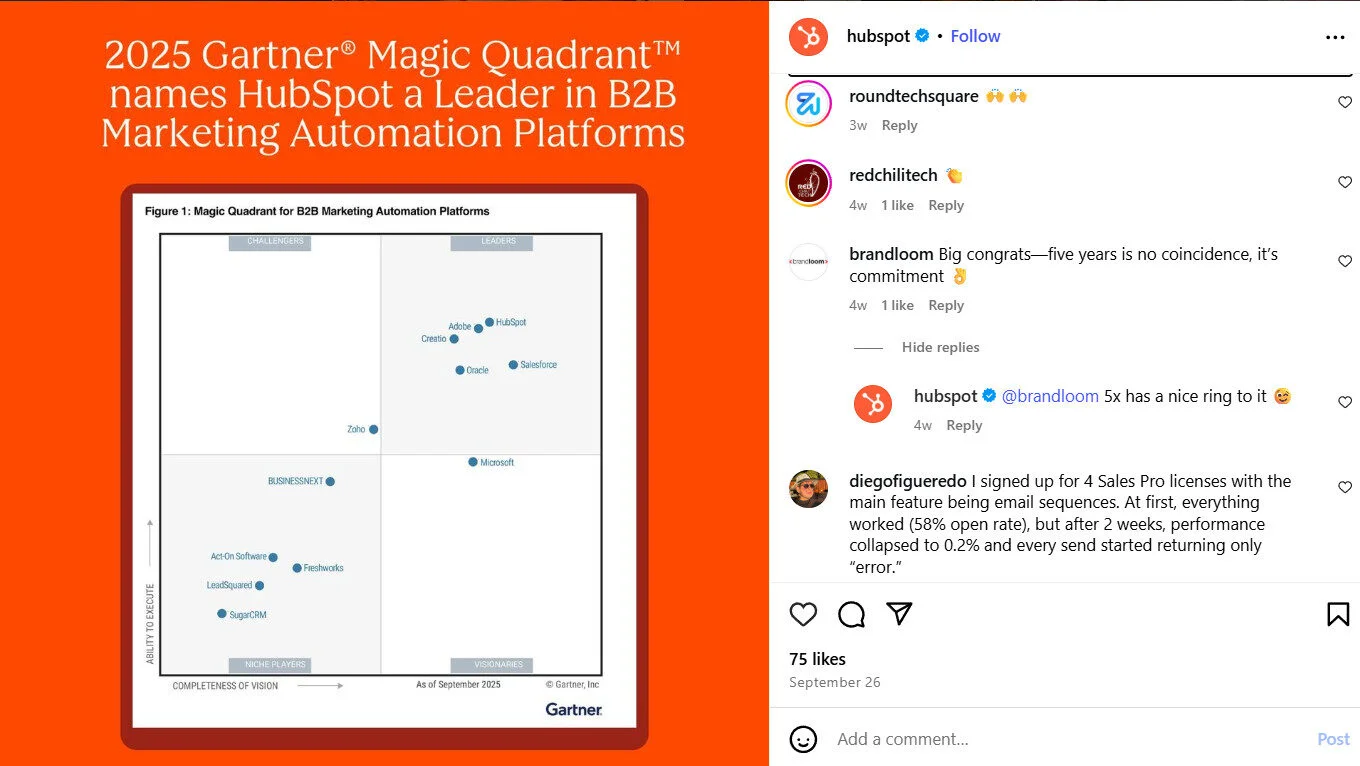
Their thoughtful replies on social media spark meaningful conversations that build trust and loyalty. This personalized engagement not only strengthens their community but also leads to higher-quality leads and conversions.
Tip: Never rely solely on automated messages or pre-written replies. Take the time to respond like a human and make your audience feel heard and acknowledged!
Avoiding Social Media Mistakes for a Stronger Brand Presence
Building a brand on social media doesn’t mean doing everything right from day one. It would obviously take you some time to learn, adapt, and strategize.
The key here is to stop guessing and start acting on data and social media trends, be very specific as to whom you are talking to, and what’s your brand voice. At the same time, consciously make an effort to avoid these common social media mistakes.
Reply thoughtfully and focus on building real connections and credibility through your social media posts.
To simplify your social media journey and get meaningful insights, you can rely on social media management tools like SocialPilot. It can be your effective all-in-one partner that lets you manage, analyze, and grow your social media accounts.
Try the free version today and see how it works for you.

